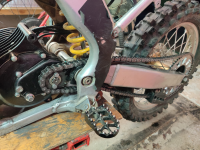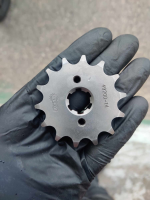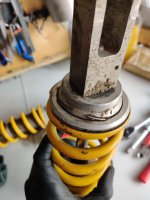
I think this is the one. It's exactly as long as the one that came with my bike, but seems properly serviced and with appropriate pressure. I set the static sag to 18mm and it immediately rides much better now, almost no kicking from the rear, all of that from middle-of-the-road settings, which to me is a good indication I'm very close with the setup. All that's left is playing with the settings a bit, and then i can decide which one to give out for service.
The one with the white spring is another shorter one from 450. That one is actually damaged, so i might use it as a first practice piece - and the spring seems extra stiff, so that's good to have in my arsenal.
I also reprogrammed the controller after putting 15T in:
Phase current: 8600 -> 9000
rate of rise: 60 -> 120
busbar: 100A -> 150A
sport busbar: 200A -> 250A
low gear speed -> 50% -> 40%
low gear current -> 100% -> 50%
mid gear current -> 100% -> 80%
I did some "datalogging" by the means of screen recording my phone with the BMS app open. The readings are very close to expected, with a maximum of 17kW I was able to get on 40% battery left. I also recorded the cell screen by accident, which at first I was very annoyed with, but then I realized i can actually look at how much the cells are sagging under load, which is a useful indication.
As a matter of fact, here's the power/voltage video:
It's dropping from 72V to 64.3V, or 0.39V per cell. I don't know how bad it is, seems like quite a lot.
And here's the individual cells:
One more thing that came to mind, related to the power modes; I'm pretty sure either my switch or the wire from mode select is broken. At first I thought the surging in L mode was caused by improper tuning, but now I'm pretty sure it's actually getting out from L into the default, much faster M. If I had my screen done, I'd see that immediately, but alas... Time seems scarce these days. I observed no discernible power/current difference between the modes, anyway, they just seem to limit the RPM.









